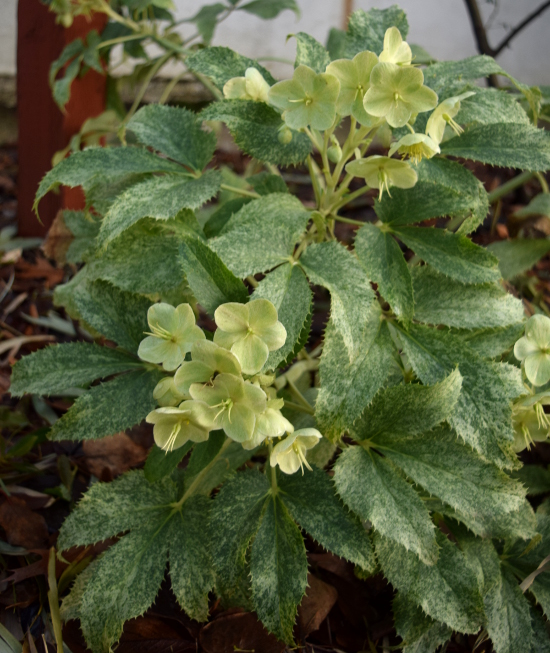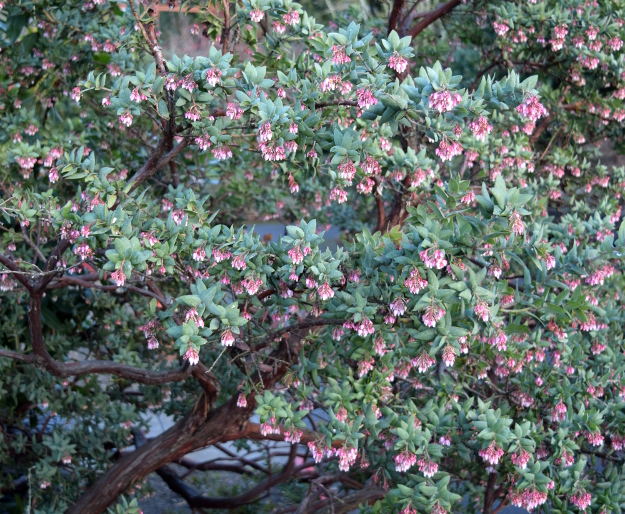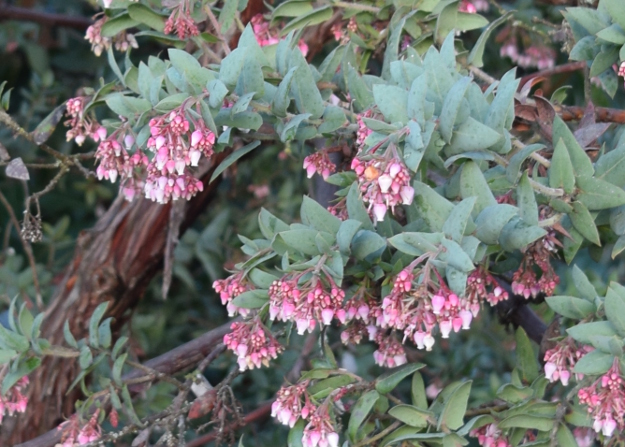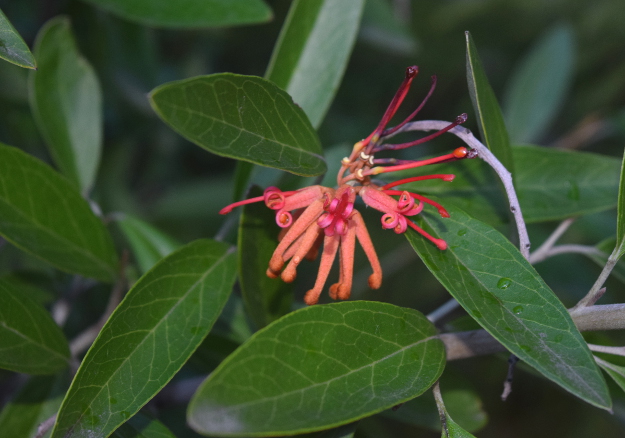Let’s face it, “winter interest” in the garden often amounts to a few somber evergreens, a spray of colorful berries, and some shreddy bark. Honest-to-God winter flowers are rare, and flowers on January first? Well, that’s asking a bit much. Or so I thought. I went to Edgefield McMenamins in Troutdale, Oregon on New Year’s Day to take some “winter interest” photos and ended up with some lovely winter flower shots!

Wintersweet (Chimonanthus praecox) is a gawky shrub that redeems itself now with the fresh, sweet fragrance of its blossoms. The pale yellow blooms, downward-facing and somewhat crumpled, would be easy to pass by, but the scent stops you in your tracks. The variety flowering now is probably ‘Grandiflora’, with larger blooms than the type and purple markings inside the flower (the later-blooming ‘Luteus’ is all-yellow).
It would be advantageous to site wintersweet where you could view the flowers from below. This isn’t hard, since the shrub can reach 10 feet tall and wide. Because it skips out on paying the rent the rest of the year, it would be a good idea to run a clematis or some other vine through it to give it some more seasonal interest besides winter interest. If you don’t have room in your garden for a 10-foot shrub, you can always espalier it against a wall.
Wintersweet is solidly hardy in zone 7 and is definitely worth trying in zone 6. It appreciates full sun or light shade, average water, and good drainage.

Corsican hellebore (Helleborus argutifolius) has started to bloom around town. This is a tough old bird with stiff, cardboardy, evergreen leaves with unfriendly prickles all around. It tolerates more sun and drier soil than other hellebores. I have even seen it in full sun hell strips. It is hardy to zone 7.

The greenish to cream colored flowers look smashing against the deep green foliage, and the blooms last a long time in the cool winter air. There are several variegated forms, and the variegation often comes true from seed, so try sowing some seed if you have a variegated one, or just watch for seedlings around your plant.

Arctostaphylos pajaroensis ‘Paradise’ made me pinch myself. January first? Really? This is magical. I need some manzanitas in my life. This one is from California and is hardy to 15 degrees or so.
Manzanitas are perfectly adapted to dry summer, low humidity (at least in summer) climates and many don’t need a drop of supplemental water once they’re established. They’re perfect for my free-draining soil (I have gravelly loam, don’t hate me). I want a low-water garden in my front yard, but I don’t like cactus or a lot of pokey desert things, and plants like manzanitas will give me the lush look I prefer, while keeping irrigation to a minimum.

Manzanitas offer handsome evergreen leaves in green, blue-green, or silver; gorgeous shaggy or polished bark (‘Paradise’ is shaggy); and pretty, bell-shaped, pink or white flowers in winter or spring. The resident Anna hummingbirds adore the winter flowers. I think no matter how long I live in Oregon, I will never stop being amazed and thrilled at seeing hummingbirds in the winter. And yet, I’m too damn lazy to keep a hummingbird feeder clean, filled, and unfrozen all winter. So manzanitas it is.

I’m beginning to realize I need a grevillea or two as well. This is Grevillea victoriae, an evergreen shrub from Australia. These fascinating flowers can appear at any month of the year but are most abundant in winter and spring. Hummers love these blossoms, too.
Grevilleas are naturally adapted to growing in very poor soil and by fertilizing them or growing them in too-rich soil you can kill them with kindness. They are especially sensitive to phosphorus. Even without fertilizer, G. victoriae is a fast grower and will shoot up to its mature height of 6 to 10 feet in no time. It is hardy to zone 7b.
Do you have any January blooms where you are?


Jan 1st blooms in Cincinnati: Oddly, _Hepatica americana_ — this single, 1-gal plant purchased/ planted in mid-summer and has been blooming since early December. Deer damage to plants & soil on this property have left me with no established stands for comparison.
Am watching the ‘Dawn’ viburnum, but with night temps plummeting to mid-teens on Wednesday, nothing likely this week.
New Year’s joy remains in subtle, ever-changing foliage color of various heucheras, the array of lichens brought to ground by ash limbs raining from the sky, colored-twig dogwoods, shreddy barks and swelling buds. 😉
What a brave little hepatica! We are definitely spoiled here in Portland with so many things blooming all winter long. When I lived in Cincinnati I appreciated the subtle joys of winter more because that’s all there was. There was also more of a feeling that spring was earned and the first flowers were more precious.
Erica x darleyensis is blooming in my garden, with Erica carnea getting close to bloom. I want more winter-blooming heaths, though not as much as I want more Arctostaphylos. I have a few flowers open on Arcto. hookeri ‘Wayside’, hoping the plants flush out with lots of growth in spring, as they were very sad rescue plants. I have several other Arctostaphylos and a few different Grevillea, but they’re all too young to bloom at the moment. Lonicera fragrantissima could open any day, and probably would be now if the plants were more mature and had more flower buds. Edgeworthia chrysantha ‘Akebono’ has had one or two flowers open since mid-December. It just can’t wait until spring (I know the feeling). Abutilon megapotamicum may have flowers under the snow, definitely has buds. My Helleborus argutifolius started opening in December and didn’t like how cold it got, so they’re a little blah. ‘Jelena’ witchhazel has been opening for a couple weeks now. Probably stalled in this cold. Garrya elliptica is open now, though it may technically be past blooming. Hard to tell with those tiny flowers.
Oh yeah, I always seem to overlook the heaths. I did see a nice white one at Edgefield. The edgeworthias were all in heavy bud, no flowers at all, but they are all the yellow, no ‘Akebono’ there. The witchhazels were only showing the slightest slivers of color. I don’t think they have Garrya, I’ll have to check Kennedy School. Some other plants I left out were Viburnum ‘Dawn’ and Daphne bholua.
Nothing doing here but we are always a bit behind gardens in town. In the meantime, I’m enjoying your photos and especially your writing style.
Thanks, Ricki!
My ‘raydon’s favorite ‘ aster is still in bloom here in the Piedmont of North Carolina. The ‘peggy clarke ‘ prunus mume has heavy buds ready to emerge any day now and the ‘christmas ‘ holly and Nandina are full of bright red berries. We’ve only had a few days of freezing temperatures this winter season.
I LOVE that aster. Need to get one. No action on the neighbor’s Prunus mume. We are actually having a pretty chilly winter, by Portland standards. Thanks for commenting!
If I want a January bloom, then I need a silk tulip. Amaryllis don’t even grow for me because my sunny facing windows have been treated with light reflecting film to keep us from melting in the summer. I wish manzanitas grew in Virginia.
I very rarely saw January blooms all those years I lived in Cincinnati, so I know how you feel. I kind of feel bad about gloating. Kind of. 😉
New Years day is the best day in the year for a long walk. I went up into the Yorkshire Dales this year for a long walk with family. Thankfully the afternoon brought some sunshine and we were not completely soaked by the time we got back to our cars. I got some fantastic pictures of beautiful scenery.
All times of the year have their beauty. I love a good winter walk, too. Glad you were able to get out and enjoy it. Happy New Year!
Thank you for this great article. I live in zone 5 b and didn’t have any flowers blooming in winter, but a little blue flower “Rocky Diamond Blue Heart” was blooming very late in the season till the middle of December.
I have seen it then still blooming under some snow. You can read about it on my blog: http://bit.ly/2hCBXIS
Amy Campion are you the daughter of Joe and Ruth?
I came across your delightful writings and helping Mason to be a gardener.I loved it!
When I scrolled through blooming Winter Shrubs I came across a description of a beloved shrub outside our L.R. window that I have been trying to identify:Grevillea Victoriae.This shrub needs to be as prevalent as Daphne Odora!
Ron my husband worked for Joe Campion at 3M in Minnesota and we heard stories of their bright well traveled children.
I am subscribing,
Thank you,
Nancy